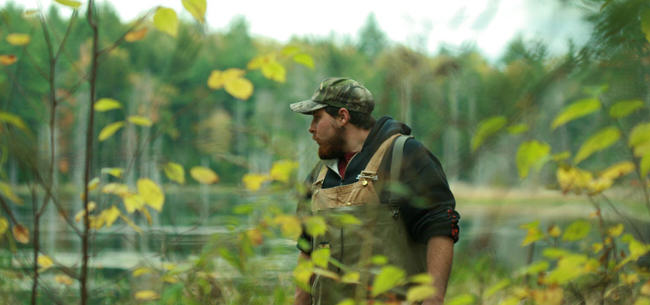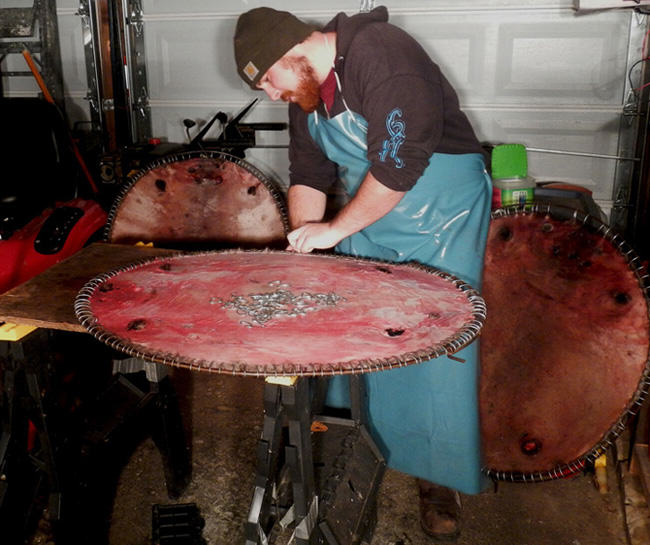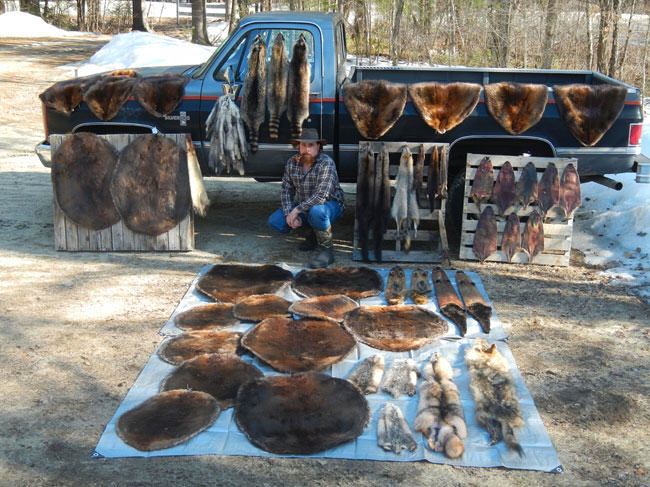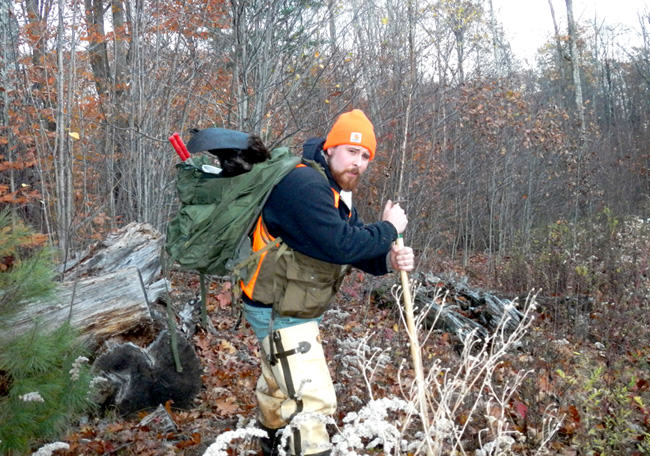
The morning started just like any other during my fall trapping season this past November. I fumbled about as I awoke to the sound of my alarm clock just before sunrise. I didn’t really want to get up; I had spent several hours in the fur shed the night before, processing otter and beaver hides and, frankly, I felt as if I had just put my head on the pillow. So goes the life of the modern trapper.
The majority of trappers in the “lower 48” nowadays are part-time fur harvesters, holding down regular day jobs while juggling activities like fur trapping. We bare the same grit as the long-line mountain men of the northern wilderness, but return to civilization after running the trapline. If you work hard enough, chances are pretty good you could make a mortgage payment with the stack of fur pelts harvested at the end of the season. Some years, when the fur market is down, you’re lucky to recoup your cost for fuel and supplies. I harvest a modest and diverse collection of prime pelts each season, and rather than send to the overseas fur markets, I sell tanned finished pelts locally in the form of crafts, garments like mittens and hats, or as unaltered skins ready for locals to make their own natural garments out of. Most modern trappers aren’t in it solely for a few extra bucks – conservation, heritage, family-tradition, exercise, insight, an escape outside, take your pick; there’s millions of reasons why modern trapping is alive and well in North America. We’re not quite Hugh Glass material, but we sure aren’t “flatlanders” either!
Senses on High Alert
With the alarm clock still buzzing, and before my conscious self could protest, I found myself already in yesterday’s pair of flannel-lined jeans, and in my truck. The drive down off the hill and into the valley is a ride I know all too well, especially during trapping season. I arrived at my first chunk of land on the trapline; a winding maze of hills, valleys, brush, and swampland carved into the side of a southern New Hampshire mountain range. I strapped on my hip-waders and slid my arms through the damp Alice pack filled with trapping supplies as I follow my bushwhacked trail through the dense Alder brush. I trekked into the still and dense forest as the sun began to break, putting a slight end to the constant hum of the pitch-black hillside.
The sights, the sounds, and the smells put my senses on high alert. What I see, touch, feel, and experience, you can’t acquire on a simple weekend hike through the woods on a walking trail. It’s something that can only be experienced when you fully immerse yourself into your natural environment and fulfill the role as a fixture of that environment, rather than a visitor. It’s real, raw, and organic, and it’s something only another trapper can fully understand. As I walked the same stretch of stream bank I’ve walked for the last thirty days, I stopped to take notice of a fresh mound of mud and stream debris piled high in a stumpy pile on the bank. It was clear these were fresh territorial markings from a beaver – markings that were not present during the previous day’s trek.
Suspicions are confirmed as I come upon my first trap lying on the river bottom, with a prime beaver lying motionless in the 330 Conibear trap’s strong and efficient grip. I take a moment with every creature I trap to reflect. I study the animal from top to bottom, noting any odd characteristics to its appearance. I give a brief “thanks” to the forest, reset the trap, and stash my gift from the woods on the river bank to be picked up on the return trip. Two beaver would be hauled out that morning and I would readily admit there are some days I get pretty tired of hauling 60 to 120 pounds of dead weight up the brushy hillside. The cycle repeats itself every morning before I head to my job back in civilization.
No “Wait Until the Weekend”
The day’s catch is left on the cool floor of my garage, as I get changed and suited up to start my workday. I return home in the evening to skin and process the furbearers I trapped that morning. There’s no “wait until the weekend” when it comes to trapping. Your catch must be handled quickly to keep up with the season’s demands. The animals are skinned and the hides are fleshed, stretched and dried. I remove any edible meat, useful bones, and glands from the remaining carcass. I take a moment to envision the usage for each pelt; which ones will make mittens, and which ones are better suited for blankets or hats. Some pelts may provide relief for a mortgage payment, and others may pay for fuel during the long Northeast winter.
This is the life of many trappers – cut from the same loins as the Alaskan and Canadian fur trappers of the uncharted lands, except our trade is carried out on the fringes of modern society and civilization. For many of us, the lifestyles of characters like Jeremiah Johnson and Hugh Glass are a prideful glimpse into a simpler time in America’s history. I consider myself fairly self-reliant by today’s standards. I’ll admit however, I’m far from the homesteading mountain men of the far north that so many of us envision. It’s the duality of being able to run a wilderness trap-line, brave the harshest of natural elements, and work a full-time job afterwards that I think makes the modern trapper such an interesting element in today’s overworked society.

The majority of my trap-line is carved along borderlines of modern metropolitan areas. The modern trapper utilizes culverts and freeway bridges to our advantage, stacking up catches that would make any 1800’s pioneer blush. Much like the furbearers we seek, we have adapted and learned to co-exist with modern society nipping at our heels. We stubbornly cling to traditions passed on from generation to generation. I find immense beauty in the fact that I can harvest my fair share of otter and fisher in the undisturbed wild mountains, and, in the next breath, head 25 minutes east and stack up a modest catch of muskrat and mink from the spillways behind the local strip-malls.
When I was younger, I scoffed at the idea of running an “urban trap-line”. I always felt wild critters could only be caught in wild places, well off the beaten path. Raccoons and opossums are synonymous with the urban setting, but in the early years, my naive thought process pictured most critters to be bound to the remote stretches of New Hampshire. For years I always sought the darkest, thickest hillsides I could find in my area. It wasn’t until I dove head-first into the world of Wildlife Damage Control that I realized just how close these creatures lived to the human populous; or should I say, how close humans live to them.
First Line of Reporting
I’m often told trapping has no place in the modern world, and I need to “evolve”. Some say it’s antiquated, outdated and obsolete. I would argue that despite public perception, few people champion our wildlife and wild resources more than the modern fur trapper. Not only are we fully vested and immersed in our natural world, but we are also the first line of reporting and observation for all aspects of furbearer biology and general wildlife conservation. We are the first to feel and report dramatic population decline, disease, and environmental issues affecting furbearing species of wildlife that would be otherwise overlooked. For example, muskrat and weasels are not typically at the forefront of yearly headcounts by biologists, and until these animals start disappearing from the landscape, there wouldn’t be any checks or balances for their overall population health if it were not for the reporting and harvest by the modern trapper. Any unbiased furbearer biologist will tell you trapping plays an important role in the North American Model of Wildlife Conservation; this is fact.

Public Perception Problem
Public perception has certainly taken its toll on the modern trapper. Somewhere down the line of American evolution, we began to set social norms for what was deemed “okay” for harvesting our nation’s natural resources. Killing for food, for instance, is generally socially tolerated, while taking an animal’s life for a beneficial garment is somehow deemed “selfish” or “greedy”. At some point, we seemed to lose the bearings of our moral compass, shaming perceived “luxury items” like fur garments as “materialistic” while we wait in line for the latest and greatest smart-phone or sports car. Here in North America, super PACs and politicians spend billions of dollars in an attempt to outright ban activities such as trapping, all the while turning their backs to the millions (yes, millions) of wild animals wasted daily on our nation’s roadways. The acts of modern regulated hunting and trapping will never hold a candle to the immense suffering man’s inadvertent progression has placed upon our fragile wildlife species. Deforestation, housing development, pollution, infrastructure, and rapid population growth all take their toll on wildlife. What’s rarely reported in the media or brought up in debates is the trapper’s ever-watchful eye over our natural resources. Our tools have also evolved with ethical and humane treatment being the primary focus.
As modern trappers, we will continue to do what we know and believe to be right, and support managing our natural resources with moral wisdom. We’ll set our traps for pelts, and assume our role in modern wildlife conservation. The fur trapper lives in a modern world, and we must constantly fight being totally forgotten by our own kind. As our society continues to redefine itself, more people seem to be seeking to move further away from the daily grind and closer to the land, and I hope the interest in trapping and the understanding of its immense value will continue to grow. If the modern trapper’s solitary watch were to be removed from our woods, North America’s natural beauty would certainly lose another layer of defense against our own industrialization.

FOLLOW JEFF TRAYNOR’S “LIVE FREE AND TRAP” ON:















Trapping is and will always be a part of who I am for it is not a job,it is a passion and respect the land and all the creatures that we as keepers of this renewable resource RESPECT AND PROTECT by maintaining a healthy population so that there are always creature’s for all of Humanity to view,PETER PEMBERTON / Wild Land Trapping
This writer has captured beautifully, the truth about trapping. It is a way of life that respects all of the earth, people, wildlife, and all of nature; one where people can truly heal mind, body, and spirit.
Do you trap live animals.
I am looking for a pet Ermine.